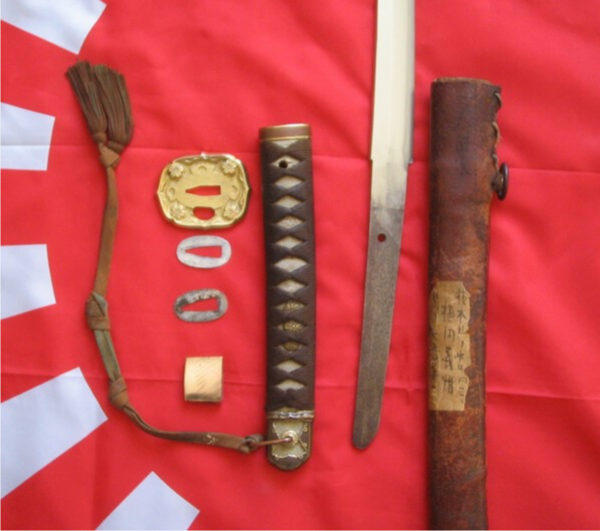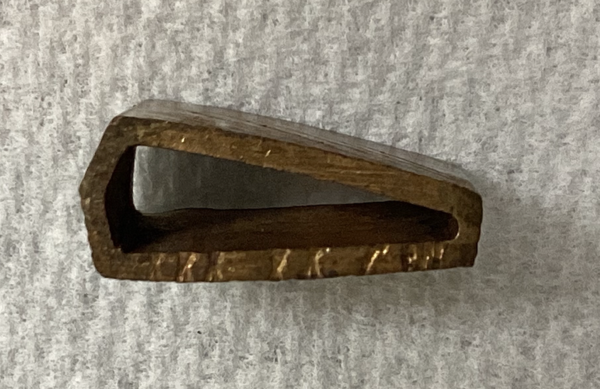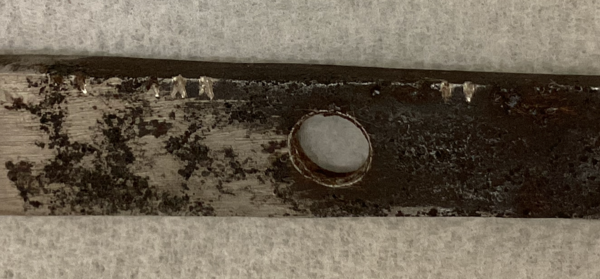
John C
Members-
Posts
2,397 -
Joined
-
Last visited
-
Days Won
15
Content Type
Profiles
Forums
Events
Store
Downloads
Gallery
Everything posted by John C
-
Breaking News On The All-Brown Army Gunto Tassel
John C replied to Bruce Pennington's topic in Military Swords of Japan
I noticed the other color and waffled a bit. I eventually settled on shiny dirt but you are probably right (I mean you are correct). John C. -
Breaking News On The All-Brown Army Gunto Tassel
John C replied to Bruce Pennington's topic in Military Swords of Japan
@Bruce Pennington Here is a pic posted by Didier (Yukihiro) a couple of years ago. It looks gunto but has the civilian fuchi and (dirty) brown tassel. John C. -
Pet Dragon Solves Faux Roman Numeral Mystery!
John C replied to Bruce Pennington's topic in Military Swords of Japan
Ha! This one came with a broken wire and stuck sakura screw. Screw was no problem to get out. Someone jammed it in because it is too long. Probably a replacement. I also found it interesting they tried to stamp the 58 as XXX + XX + whatever, rather than just / + /III. John C. -
@Bruce Pennington I just acquired a standard naval dirk that has what I believe to be the Nakano Shoten mark (page 44 of the stamps doc) on the guard. But there is a slightly different mark listed on page 9 of the stamps doc from Fuller that indicates it is also found on naval dirks. Could they be the same mark? Under a loupe, mine looks like more like the Nakano Shoten listed on page 44. Just curious. John C.
-
Pet Dragon Solves Faux Roman Numeral Mystery!
John C replied to Bruce Pennington's topic in Military Swords of Japan
Bruce: Have you seen the roman numeral system used on naval dirks? I recently purchased a dirk that looks like someone attempted to mark the parts using roman numerals, however the marks look new. John C. -
The tassel does not seem to have the same wear and tear as the rest of the fittings. Seems rather clean and un-frayed. Is the fuchi late-war or gunzoku? John C.
-
-
Rowan: Just my two cents, however I agree with the others. I have the same problem with one of my blades from a 40 year + fingerprint. I have also seen acid from prints and sweat permanently etch a pair of handcuffs! John C.
-
Unfortunately not. Nihonto is not my main area. But, to my untrained eye, the mei looks a little "loose" - meaning not written in a flowing, confident manner. It's a bit sloppy. Remember, however, that blades and signatures run the gamut from excellent blades that are mumei to really bad blades with big names on them and everything in between. It is a nihonto and it should be preserved. You own a real piece of history; that's the fun part. John C.
-
Nick: Here is a link to get you started: https://www.bushidojapaneseswords.com/about-us.html Ted Tenold would be another. But as Franco said above, the process is expensive - about 70-100 dollars per inch! Personally, I would do more research on the mei first to be reasonably certain it is legit before dropping that much cash on a polish. In the meantime, you can read-up on some of the preservation methods discussed on NMB (i.e., oiling the blade, using uchiko powder over a period of time, etc.). John C.
-
Ah, thanks. I thought maybe it meant a "tired" blade but it's just the opposite. John C.
-
Colin: I am still rather new to this...what does that mean? John C.
-
Determination of the name of the swordsmith.
John C replied to Felix's topic in General Nihonto Related Discussion
I can't make the stamps out exactly, however very common to have showa or gifu inside the sakura petal. It would indicate the blade came from an arsenal. John C. -
Breaking News On The All-Brown Army Gunto Tassel
John C replied to Bruce Pennington's topic in Military Swords of Japan
Here's a gunzoku with the remnants of a brown tassel on Ebay now. https://www.ebay.com/itm/334889216905 John C. -
All of the above I should think. It seems the longer a sword has been around, the least likely it will have matching numbers. This lends credence to the observation that souvenir swords, for the most part, have matching numbers because they were not used in combat. And by matching numbers I mean the painted nakago numbers matching the numbers stamped on the fittings. John C.
-
Thank you, Mark. I had a note about Yasuki steel but it started with a different kanji, which is what threw me. John C.
-
One the reverse side of an Asano Kanezane blade. The first character looks like An as in Ansei, though that wouldn't make sense given the smith. Any help would be appreciated. John C.
-
This is what makes the whole assembly number thing interesting to me. The fittings are made for a particular sword so they need to keep track. But with the possible exception of souvenir swords, the numbers on the blade usually do not match the numbers on the fittings. Lots of reasons for this - damage to original fittings usually - but why do replacement fittings all have the same number? If the entire set were remade, I would think the numbers would match the blade; if the parts were piece-meal (use whichever one fits), I would expect there to be a variety of fitting numbers on each blade. I also think the reason we see consistent numbers on souvenir blades and fittings goes back to damage - not being used during the war means less damage and less chance of needing, or even finding, replacements. I just think there is something more to the "assembly number" thing than what we currently know. And I get that I am the lone voice in the wilderness on this, however I would like to complete the puzzle - even if I know what the picture already looks like. John C.
-
The overall shape of the nakago and alignment of the machi seem legit, though. Bohi looks okay. Not sure about this one. Just my one-and-a-half cents. John C.
-
It's a gendaito made in 1944. I am not 100 percent sure of the regs imposed by the Occupying forces, however I think it would have been illegal for someone not under contract by the Army to hand forge a sword right after the war. I think that may have changed around 1952 or so? Not sure. John C.
-
The mei on my Kanehide gendaito has the green assembly number paint inside as well. So clearly applied after the sword was finished. But when, where, by whom, and for what exact reason are the questions I am trying to answer through a study of assembly numbers. Nothing interesting to report so far. The only patterns I have identified to this point are that 1) some smiths (or shops; or factories) used the same paint color consistently and 2) the number of digits seems to be consistent (usually 2,3, or4 with some having a katakana or western letter prefix). John C.
-
Thank you guys. I am interested in this topic. But could "Oshima" have sold or given the sword to Lt. Kume? That would mean Oshima could still be the original owner, although I think in any case it was put there by the shop - either as their name or the name of the person who ordered it. Just thinking out loud, John C.
-
I think you are right that we just can't pin it down yet. It would be nice to know if those ladies were in a shop or in a factory. Long hallway like a factory but I don't know anything about what a shop may have looked like. Based on the numbering style and position, I still think the same person wrote them. But where, I have no clue. John C.
-
Theories on the mix of Western and Japanese numbers on gunto
John C replied to John C's topic in Military Swords of Japan
Makes sense. On my type 98, all of the fittings have beautifully stamped kanji numbers except the one part that is hidden. The wooden saya insert has the Western numbers. John C. -
I see it now. Then I think definitely final polish before delivery. John C.











